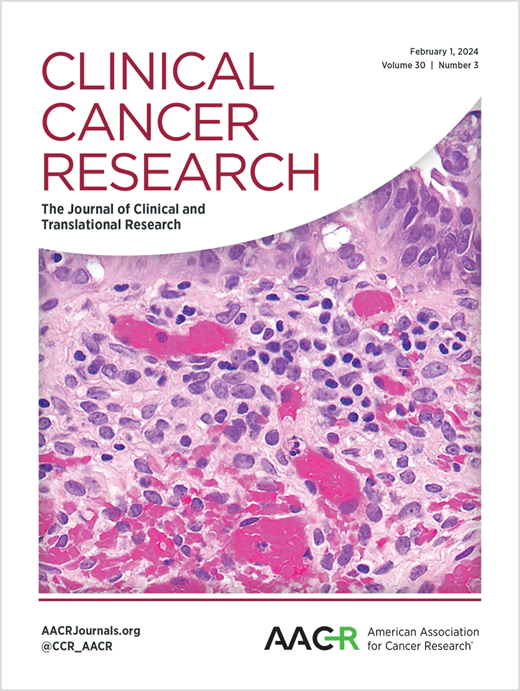晚期非小细胞肺癌患者停止免疫检查点抑制剂治疗免疫相关毒性后与疾病进展相关的因素
IF 10
1区 医学
Q1 ONCOLOGY
引用次数: 0
摘要
目的:在因免疫相关不良事件(irAE)而停用免疫检查点抑制剂(ICI)的晚期非小细胞肺癌(NSCLC)患者中,停药后的临床结局以及与停药后疾病进展相关的因素在很大程度上尚属未知。实验设计:从接受 ICI 并因 irAE 而中断治疗的晚期 NSCLC 患者中抽取临床病理数据。评估与停药后无进展生存期(PFS)和停药后总生存期(OS)相关的因素。结果显示在2794例患者中,10%(N = 271)的患者因irAE而停用ICI,因irAE而停用ICI前的中位治疗时间为5.9个月(范围为0.03-73.5)。因irAE停药前的治疗时间越长,停药后的疗效越好:在因irAE停药前服用ICI 3个月(89人)、3至6个月(49人)和6个月(133人)的患者中,停药后的PFS中位数分别为6.2、13.9和25.5个月。2、13.9 和 25.8 个月(P < 0.001),停药后的中位 OS 分别为 21.7、42.7 和 86.9 个月(P < 0.001)。在多变量分析中,PD-L1≥50%、对治疗的完全应答/部分应答(CR/PR)和停药前治疗时间在3至6个月和>6个月之间是停药后PFS延长的预测因素;非鳞癌组织学、CR/PR和停药前治疗时间>6个月是停药后OS延长的预测因素。为控制毒性而使用免疫抑制剂不会影响停药后的疗效。结论停药前更长的治疗时间、CR/PR的最佳客观反应、PD-L1≥50%以及非鳞癌组织学可帮助临床医生识别停用ICI治疗irAE后疾病可能得到长期控制的患者。本文章由计算机程序翻译,如有差异,请以英文原文为准。
Factors Associated with Disease Progression after Discontinuation of Immune Checkpoint Inhibitors for Immune-Related Toxicity in Patients with Advanced Non–Small Cell Lung Cancer
Purpose: Among patients with advanced non–small cell lung cancer (NSCLC) who discontinue immune checkpoint inhibitors (ICI) because of immune-related adverse events (irAE), post-discontinuation clinical outcomes and factors associated with disease progression after discontinuation are largely unknown. Experimental Design: Clinicopathologic data were abstracted from patients with advanced NSCLC who received ICI and discontinued treatment because of irAE. Factors associated with post-discontinuation progression-free survival (PFS) and post-discontinuation overall survival (OS) were evaluated. Results: Of 2,794 patients, 10% (N = 271) discontinued ICI because of irAE, and the median duration of ICI treatment before discontinuation for irAE was 5.9 months (range, 0.03–73.5). A longer treatment duration before discontinuation for irAE was associated with improved post-discontinuation outcomes: for patients on ICI for <3 months (N = 89), 3 to 6 months (N = 49), and >6 months (N = 133) before discontinuing for irAE, the median post-discontinuation PFS was 6.2, 13.9, and 25.8 months (P < 0.001), respectively, and the median post-discontinuation OS was 21.7, 42.7, and 86.9 months (P < 0.001), respectively. At multivariable analyses, predictors of longer post-discontinuation PFS were PD-L1 ≥ 50%, complete response/partial response (CR/PR) to treatment, and treatment duration before discontinuation between 3 to 6 months and >6 months; predictors of longer post-discontinuation OS were nonsquamous histology, CR/PR, and treatment duration before discontinuation >6 months. The use of immunosuppressive agents for toxicity management did not affect post-discontinuation outcomes. Conclusions: A longer treatment duration before discontinuation, a best objective response of CR/PR, PD-L1 ≥50%, and nonsquamous histology may help clinicians identify patients who may experience long-term disease control after discontinuation of ICI for irAE.
求助全文
通过发布文献求助,成功后即可免费获取论文全文。
去求助
来源期刊

Clinical Cancer Research
医学-肿瘤学
CiteScore
20.10
自引率
1.70%
发文量
1207
审稿时长
2.1 months
期刊介绍:
Clinical Cancer Research is a journal focusing on groundbreaking research in cancer, specifically in the areas where the laboratory and the clinic intersect. Our primary interest lies in clinical trials that investigate novel treatments, accompanied by research on pharmacology, molecular alterations, and biomarkers that can predict response or resistance to these treatments. Furthermore, we prioritize laboratory and animal studies that explore new drugs and targeted agents with the potential to advance to clinical trials. We also encourage research on targetable mechanisms of cancer development, progression, and metastasis.
 求助内容:
求助内容: 应助结果提醒方式:
应助结果提醒方式:


